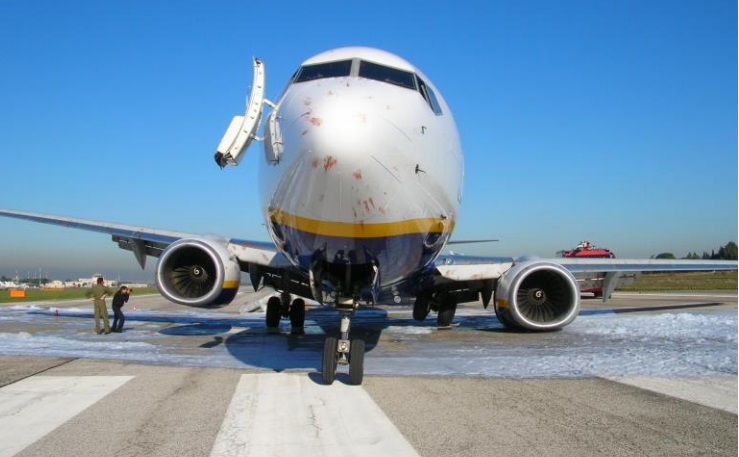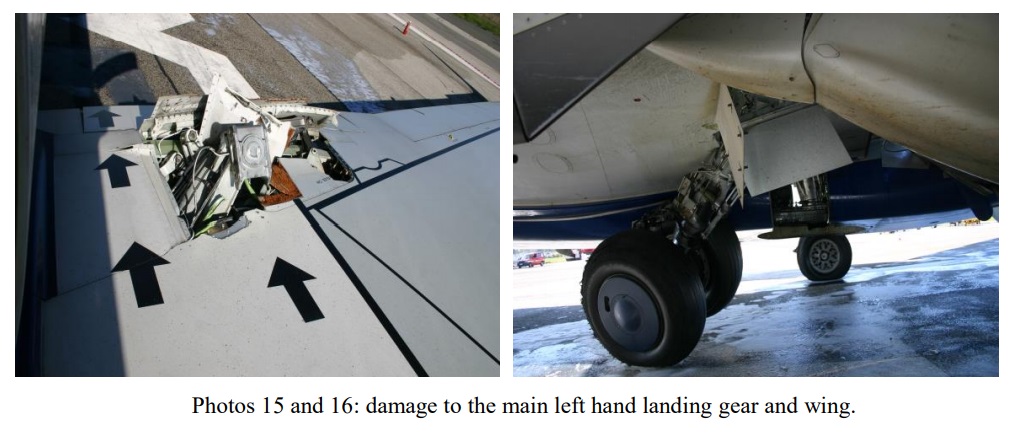Final Report Issued on 2008 B737 Bird Strike Accident in Rome
On 10 November 2008 Ryanair Boeing 737-8AS EI-DYG collided with a dense flock of starlings (typical mass 40-1o0 g) on short finals at Rome Ciampino. The Italian safety investigation agency, the ANSV, discuss this accident in a final report issued 20 December 2018.

Ryanair Boeing 737-8AS EI-DYG After a Bird Strile Laning at Rome Ciampino 10 November 2008 (Credit: ANSV)
The crew spotted the birds and being aware of the relatively short 2207m runway, initiated a go-around around 100m from the threshold at approximately the same time as impacts occurred. The crew said these sounded like hailstone impacts.
However, both engines were unable to deliver sufficient thrust, with N1 (fan speeds) dropping from 62% to 41%. The aircraft, with 172 persons on board, rapidly lost speed and height.
The aircraft hit the ground about halfway down the runway, nose high in a near stall condition, on the main landing gear and the lower part of the rear fuselage. The left main landing gear collapsed and the left engine nacelle came into contact with the runway.
There were 8 injuries, all minor.
Investigators identified 86 bird impacts (on the radome, forward fuselage, wing leading edges, flaps undersides, engine nacelles and landing gear). While this damage would not have affected control of the aircraft, there was extensive bird debris on the stator and rotor blades of the CFM56-7B26/3 engines. Investigators identified 55 impact points on the number 1 engine fan and 30 on the number 2 engine fan.
The fan blades themselves showed little damage. The investigators identified that both engines had repeatedly surged after the impacts, which they believed to have considerably exceeded those required for certification.
ANSV Conclusions on Cause
The accident has been caused by an unexpected loss of both engines thrust as a consequence of a massive bird strike, during the go-around manoeuvre. The loss of thrust has prevented the aircrew from performing a successful go around and has led the aircraft to an unstabilized runway contact.
Contributory factors were:
- The inadequate effectiveness of bird control and dispersal measures put in place by the airport operator at the time of the accident;
- The captain decision to perform a go around, when the aircraft was at approximately 7 seconds from touchdown. This decision was significantly influenced by:
- The lack of instructions to flight crew concerning the most suitable procedures to adopt in the case of single or multiple bird strikes in the landing phase;
- The absence of specific training in the management, by the flight crew, of the “surprise” and “startle” effects in critical phases of the flight.
They also explain that the elongated completion of the report was due to retirements and staff shortages.
ANSV Safety Recommendations
ANSV-12/1525-08/1/A/8 Addressees: EASA and FAA
ANSV recommends to provide flight crews with guidelines and/or operational and training procedures, based on a careful assessment of the risks associated with the conduct of the aircraft in approach in case of birds encounter or single/multiple bird strikes. These guidelines should include the following topics: to discuss bird strike risks during take-off and approach briefings when operating at airports with known or expected bird activity; in case of single/multiple bird strikes in the final approach phase, if landing is assured, it is preferable to land maintaining the lowest engine power setting possible rather than carrying out a go-around procedure (in case of birds ingestion, especially a massive one, the engines damages can be greater at high engine rpm, the latter typical of a go-around manoeuvre); to consider that engines damages or malfunctions might prevent the go-around manoeuvre from being completed safely and consequent impossibility to land on the runway.
ANSV-13/1525-08/2/A/18 Addressees: EASA and FAA
ANSV recommends to provide indications in order to adopt specific trainings for flight crews, to cope with the surprise and startle effect, particularly in critical phases of flight such approach and landing.
Other Safety Resources
- Power of Prediction: Foresight and Flocking Birds looks at how a double engine loss due to striking Canada Geese had been predicted 8 years before the US Airways Flight 1549 ditching in the Hudson (which was just days after the Louisiana helicopter accident).
- Safety Lessons from a Fatal Helicopter Bird Strike: A fatal accident occurred on 4 Jan 2009 involving Sikorsky S-76C++ N748P of PHI that highlighted a range safety lessons. We also discuss current activity on enhancing bird strike requirements.
- Swedish Military NOE Helicopter Bird Strike: During a low-level night two-ship training flight a Swedish Armed Forces Agusta 109LUH collided with a large bird.
- NTSB Recommendations on JT15D Failure to Meet Certification Bird Strike Requirements
- UPDATE 3 January 2019: USAF HH-60G Downed by Geese in Norfolk, 7 January 2014
- UPDATE 7 November 2020: Deadly Dusk Air Ambulance Bird Strike
- UPDATE 30 December 2020: AS350B3/H125 Bird Strike with Red Kite
- UPDATE 23 March 2022: Big Bustard Busts Blade: Propeller Blade Failure After Bird Strike




Recent Comments